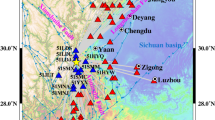Abstract
Strong ground motion of an earthquake is simulated by using both staggered grid finite difference method (FDM) and stochastic method, respectively. The acceleration time histories obtained from the both ways and their response spectra are compared. The result demonstrates that the former is adequate to simulate the low-frequency seismic wave; the latter is adequate to simulate the high-frequency seismic wave. Moreover, the result obtained from FDM can better reflect basin effects.
Similar content being viewed by others
References
Aki K. 1966. Generation and propagation of G waves from the Niigata earthquake of June 16, 1964. part 2. Estimation of earthquake moment released energy, and stress-strain drop from the G Wave spectrum [J]. Bull Earthq Res Inst, 44: 73–88.
Aki K and Richards P G. 1980. Quantitative Seismology [M]. San Francisco: W. H. Freeman, 116–117.
Boore D M. 1983. Stochastic simulation of high-frequency ground motion based on seismological models of the radiated spectra [J]. Bull Seism Soc Amer, 73(6): 1 865–1 894.
Dahlen F and Tromp J. 1998. Theoretical Global Seismology [M]. Princeton, New Jersey: Princeton University Press, 193–211.
Ewald M A. 2001. Numerical Simulation of Site Effects With Application to the Cologue Basin [D]: [Ph.D. Dissertation]. Munich: Munich University, 13–15.
Frankel A. 1993. Three-dimensional simulations of ground motions in the San Bernardino Valley, California, for hypothetic earthquakes on the San Andreas fault [J]. Bull Seism Soc Amer, 83: 1 020–1 041.
Frankel A and Vidale J. 1992. A three-dimensional simulation of seismic waves in the Santa Clara Valley, California, from a Loma Prieta aftershock [J]. Bull Seism Soc Amer, 82: 2 045–2 074.
Graves R W. 1993. Modeling three-dimensional site response effects in the Marina District basin, San Francisco, California [J]. Bull Seism Soc Amer, 83: 1 042–1 063.
Graves R W. 1996a. Simulating realistic earthquake ground motion in regions of deep sedimentary basins [A]. Proc. of the 11th World Conference on Earthquake Engineering [C]. Acapulco, Mexico, 23–28.
Graves R W. 1996b. Simulating seismic wave propagation in 3D elastic media using staggered grid finite difference [J]. Bull Seism Soc Amer, 86: 1 091–1 106.
Hanks T C and Kanamori H. 1979. A moment magnitude scale [J]. J Geophys Res, 84: 2 348–2 350.
HUO Jun-rong. 1989. The Regulation of Strong Ground Motion Attenuation on Near Field [D]: [Ph.D. Dissertation]. Harbin: Institute of Engineering Mechanics, State Seismological Bureau, 56 (in Chinese).
Levander A R. 1988. Fourth-order finite-difference P-SV seismograms [J]. Geophysics, 53(11): 1 425–1 436.
Olsen K B, Archuleta R J, Matarese J R. 1995. Magnitude 7.75 earthquake on the San Andreas fault: Three-dimensional ground motion in Los Angeles [J]. Science, 270: 1 628–1 632.
Pitarka A. 1999. 3D elastic finite-difference modeling of seismic motion using staggered grids with nonuniform spacing [J]. Bull Seism Soc Amer, 89(1): 54–68.
Pitarka A, Irikura K, Iwata T et al. 1996. Basin structure effects in the Kobe area inferred from modeling of ground motion from two aftershocks of January 17, 1995, Hyogo-ken Nanbu earthquake [J]. J Phys Earth, 44: 563–576.
Virieux J. 1986. P-SV wave propagation in heterogeneous media: Velocity-stress finite-difference method [J]. Geophysics, 51: 889–901.
Author information
Authors and Affiliations
Additional information
Foundation item: National Natural Science Foundation of China (5048003) and DAAD of Munich University, Germany.
About this article
Cite this article
Wang, Ms., Jiang, H. & Hu, Yx. Comparison between staggered grid finite difference method and stochastic method in simulating strong ground motions. Acta Seimol. Sin. 18, 582–589 (2005). https://doi.org/10.1007/s11589-005-0037-5
Received:
Revised:
Accepted:
Issue Date:
DOI: https://doi.org/10.1007/s11589-005-0037-5




